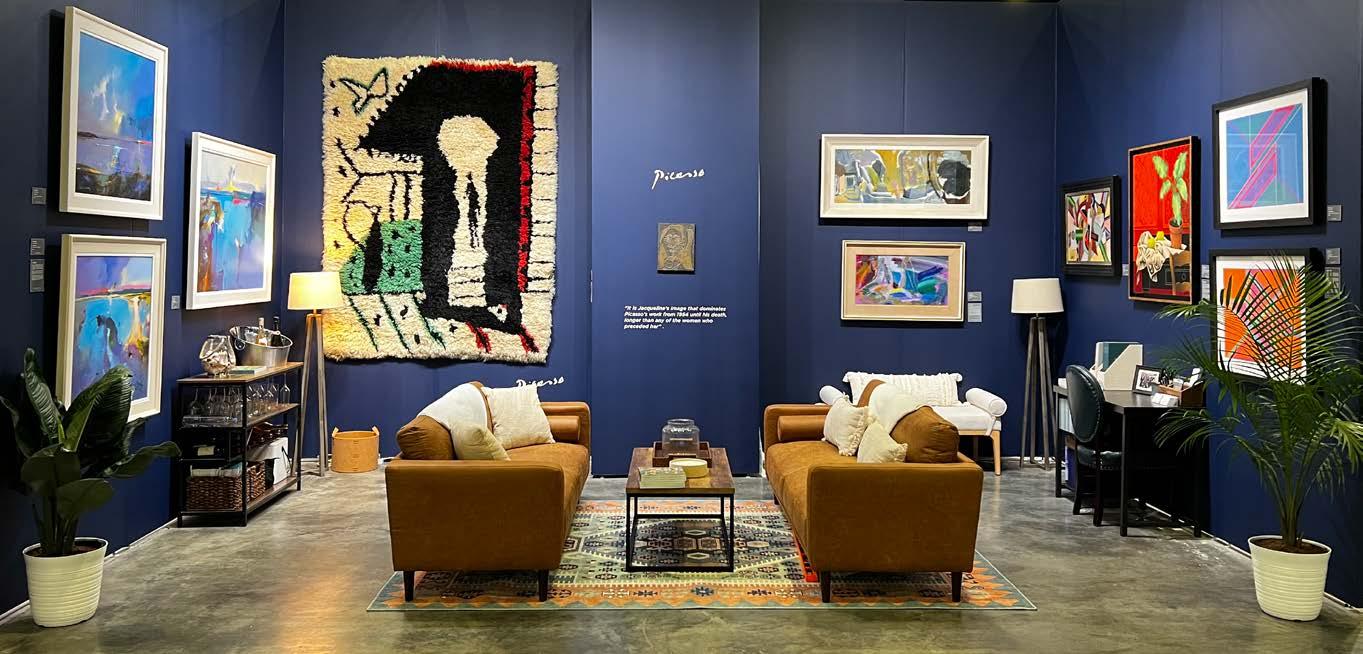
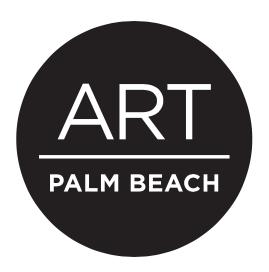
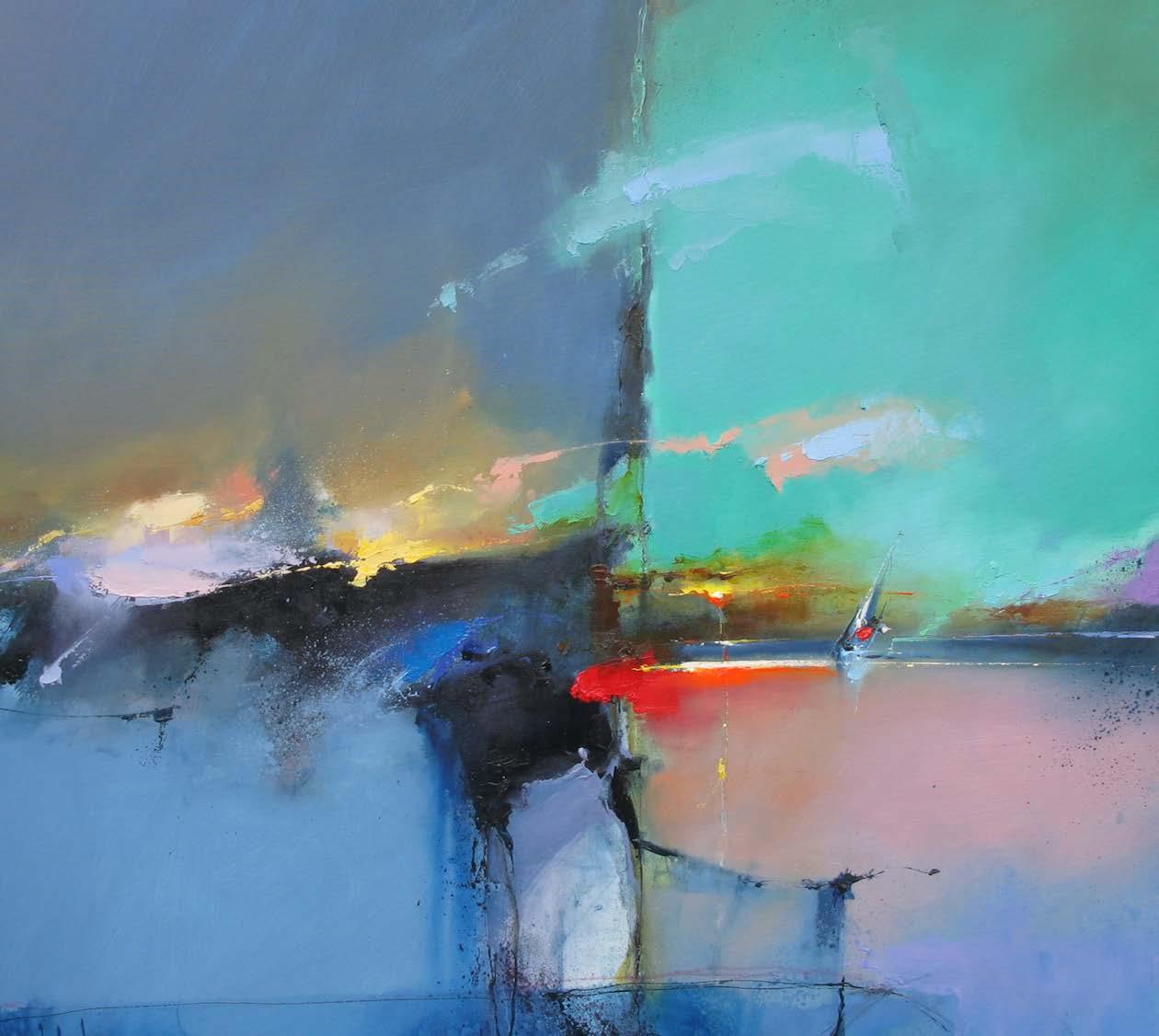
Gladwell & Patterson at Art Palm Beach
The first of our two winter Palm Beach shows, Gladwell & Patterson will be showcasing the work of several modern and contemporary artists at Art Palm Beach.
We are delighted to present works by British abstract artists’ David Leverett, whose vibrantly coloured and lineal compositions are deeply emblematic of the avant-garde British art scene of the 1960s, and Ivon Hitchens who is widely regarded as the prominent British abstract landscape painter of the twentieth century. Immediately recognisable for his daring, yet subtle, use of colour and brushstrokes, Hitchens evokes the spirit of a place in his alluring compositions. We will also be displaying works by Kenneth Webb, a follower and friend of Ivon Hitchens, whose recognisable abstract floral arrangements and vivid landscapes of the west coast of Ireland never fail to attract attention.
Over the course of our historic 275 years Gladwell & Patterson have always sought out the finest work of each genre and the exceptional cubist paintings by Georges Terzian and Georges Bauquier are such examples. Alongside these greats of Eurpoean art, we are thrilled to announce that we will be showing new works by acclaimed British artist Peter Wileman exclusively at Art Palm Beach. As Peter’s only dealer in the United States we are excited to be bringing his work to the American market.
We look forward to seeing you at Art Palm Beach and introducing these stunning artworks to you.
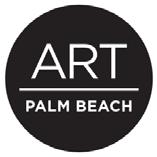
Booth 719
25 January – 29 January 2023
Palm Beach County Convention Center 650 Okeechobee Blvd. West Palm Beach FL 33401
glenn@gladwellpatterson.com


+44 (0) 7767 824 245
+44 (0) 7983 518 526
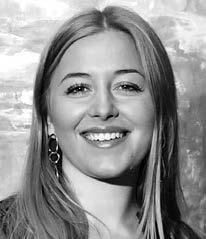
Glenn
Fuller
Emily Campin emily@gladwellpatterson.com
Looking Forward to the Past: An Illustrious 275 Years

Gladwell & Patterson is proud to be London’s oldest art gallery. Founded in 1746, by the greatest print merchant of Georgian London, John Boydell, our business has always had the goal of dealing with the finest artists of their generation. We value quality and integrity very highly, and we understand the passion and creativity that comes hand-in-hand with being so talented.
Founded in the City of London, the gallery is proud to have remained an essential destination for anyone in search of fine paintings and sculpture. It has become apparent everyone remembers their first encounter with the gallery, and no wonder - over our centuries of history we have been committed to delivering wholesome and enjoyable experience to anyone who walks through our doors or visits our stands at Art Fairs across the globe.
The gallery’s history traverses many artistic movements, it contains incredible beauty, the wonder and power of artistic creation and its ability to bring such joy, contentment and unity to the World. The foundations of this fine art gallery are based on the pioneering and passionate work of many giants of the art world over the past 275 years. Their number include two Lord Mayors of London, a man who is credited with being the driving force behind the establishment of the National Gallery, the Head of the Fine Art Trade Guild and Masters of several of the Worshipful Companies in the City, amongst many other accolades.
The earliest custodians of our business, John Boydell in the eighteenth-century, and Henry Graves in the nineteenth-century, were the most successful print merchants in London at the time, specialising in publishing engravings from pictures by Joseph Mallord Wiliam Turner, John Constable, John Everett Millais, and other contemporary painters.

T. H. Gladwell was opened by Thomas Henry Gladwell, the son of a very talented carver and gilder, at 21 Gracechurch Street, in 1836. Initially the gallery specialised in fine prints, books, and stationery, but with his father’s knowledge of carving and gilding, it wasn’t long before they had added frame making to their repertoire. By the time of Thomas Gladwells’s death in 1879, the business had firmly established itself as one of the leading art galleries and frame makers in London. Thomas’s three sons, Henry, Arthur and Alfred Thomas took over the business and renamed it Gladwell Brothers in 1880. Their extensive network of fine artists continued to expand and through their connections with European dealers and publishers such as the dealer Théodore Vibert, the publisher Alfred Cadart, and the dealer Adolphe Goupil, were vital in maintaining their position as one of the most ground-breaking, interesting, and knowledgeable art gallery in London.
Harry Gladwell, the eldest grandson of Thomas Henry Gladwell, would eventually take over the business at the start of the twentieth-century. Brought up as a hard-working, inquisitive, and religious lad, he yearned to join his father and uncles in the business. In 1875, aged eighteen, the intrepid Harry travelled to Paris to be apprenticed with the art dealer Adolphe Goupil in Paris. There, he became firm friends with another apprentice, Vincent van Gogh, who took the young Harry under his wing and showed him around the city. Vincent delighted in Harry’s idiosyncratic appearance, describing him as "thin as a stick with a pair of large red protruding ears", and his joie de vivre. Van Gogh’s letters to his brother Theo reveal the close relationship between the two young men.
Harry moved the gallery to its new home on the corner of 70 & 71 Cheapside, in the City of London, which soon became known as Gladwell’s Corner. With Harry’s experience gained through his various apprenticeships with his uncles and father and his spell at Goupils in Paris, he would go on to become the most successful art dealer of his time.
Two of Harry’s sons, Ernest and Algernon, joined their father at Gladwell & Company, learning the trade at the various branches of the company. In 1928, a year after Harry Gladwell died, the brothers went their separate ways. Algernon remained in the City and moved to a new gallery at the corner of Queen Victoria Street and Watling Street, where the gallery remained until 2012.


In 1968, Algernon retired and sold the business to Herbert Fuller, who had managed the gallery for him since 1932 and had been instrumental in steering the gallery through the hardships of the 1930s and then the blitz of London during the Second World War. Following the War, Algernon and Herbert regularly travelled to the Salons of Europe, meeting the best and most highly regarded artists with whom they started prosperous relationships. Herbert brought renowned French masters such as Georges Robin, Alexandre Jacob, Charles Perron, Edouard-Léon Cortès and Auguste Bouvard into the Gladwells fold. He introduced these artists to the British art market and subsequently around the world.
The same year that Herbert acquired Gadwell & Company, in 1968, his son Anthony Fuller joined him in the business. Father and son continued to take the gallery from strength to strength, cementing Gladwell & Company’s place as the most discreet and discerning Fine Art Gallery in London. It was the destination for any art collector wanting to build an honest and beautiful collection.
Upon Herbert’s untimely death in 1980, Anthony took over the company, and worked tirelessly to keep the old established gallery going. Anthony’s love of art soon found him his own group of clients, and there are precious few people who have met him in the gallery over the years who don’t comment on the infectious joy that paintings give him. Many people’s love of art has been founded on a few minutes in Anthony’s company with some paintings.
Anthony’s son Glenn joined the business in 1995, followed by his daughter, Cory, in 1998, following a successful and invaluable Masters degree at the Courtauld Institute of Art. In 2004 the Fuller family acquired the prestigious Mayfair gallery W H Patterson at 19 Albemarle Street. The gallery was opened in 1964 by Bill Patterson and became known as the premier gallery for contemporary artists painting in traditional styles, and artists from around the world wished to be represented by them.
In 2012, our two galleries in the City and in Mayfair were brought together under one roof in the equally distinguished environment of Knightsbridge. It is here, with the opening of Gladwell & Patterson, that two illustrious legacies combined in our new space at 5 Beauchamp Place, where we remain to this day.
In 2020 we opened the doors to Gladwells Rutland in the exclusive market town of Oakham in Rutland, offering a new and intimate space in which to show the works of our wonderful artists in the British countryside.
The Gladwell & Patterson ethos has been shaped by an informed yet fresh approach to what the separate parts have always done: presenting the finest works of art to those who appreciate them most, our perceptive, valued clients.
1
david leverett
British, (1938-2020)
Composition No. 2

Numbered ‘2’ (along top edge)
Gouache and Pencil on Card 55 x 80 cms / 21” x 31"
Provenance Estate of the Artist. Gladwell & Patterson, London; acquired from the above in 2022.
2
david leverett
British, (1938-2020)
Composition No. 7
Numbered ‘7’ (along top edge) Gouache and Pencil on Card 55 x 80 cms / 21” x 31"
Provenance Estate of the Artist. Gladwell & Patterson, London; acquired from the above in 2022.

3
David Leverett’s abstract paintings are emblematic of the avant-garde 1960s British art scene. With their large scale and irregularly shaped geometry, executed in vivid acrylics, Leverett’s paintings burst with vibrancy and dynamism.
Born in Nottingham in 1938, Leverett studied at Nottingham College of Arts in the late 1950s, where his early work demonstrated a predilection for bold, abstract forms. In 1961 he moved to London to complete his training with a further three years study at the Royal Academy, immersing himself in nascent movements of the 1960s, from Pop Art to Op Art. Upon graduation, Leverett began exhibiting almost immediately with a series of shows at the Redfern Gallery, followed by one man shows at the John Moores Liverpool Exhibition in 1967 and the Whitechapel Art Gallery in 1968. In the same year, still only thirty, his work was included at the Royal Academy Bicentenary Exhibition.
Leverett’s landscapes have enormous vitality. Preoccupied with the natural world, his compositions seek to combine the elements of water, air, sky, and earth which are always in a state of change and motion. Leverett abstracts and distorts the landscape, giving viewers the opportunity to travel in their imagination as they choose.
In his later years, he would begin to pull back slightly from abstraction, producing bold landscapes that reflect a growing concern with environmental causes. While he was perhaps best known for the geometric work he produced in the sixties, he continued to remain an important force in British art, winning the inaugural Sargant fellowship at the British School in Rome in 1990.
Alongside his painting, David was for many years a leading teacher at the Slade School of Fine Art, a role for which he is fondly remembered by numerous students. Education was clearly a passion of his, and in addition to his work at the Slade, David would often travel internationally to give workshops. David passed away in 2020 at his Kentish Town home after a career of over fifty years. During that time his work had been shown around the world, from Venice to New York and today his paintings are in multiple museum collections, most importantly at Tate Modern in London.
4
david leverett British, (1938-2020)
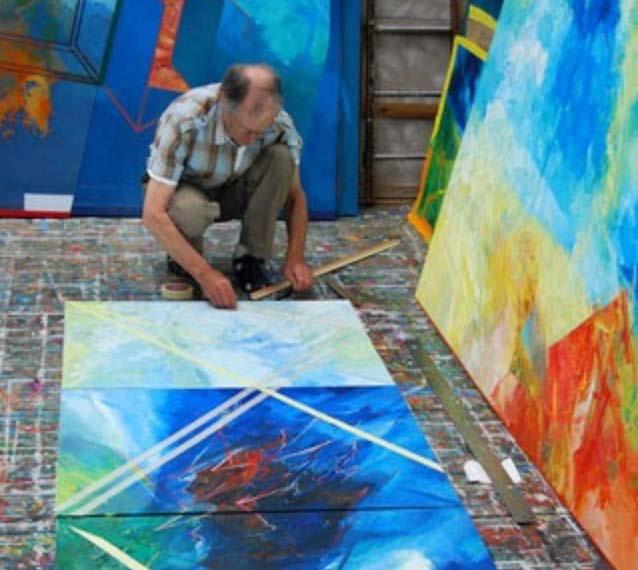
Donald Hamilton Fraser
British, (1929-2009)

“The West Coast of Scotland and the Highlands are the last wilderness in Britain, the last place where you feel alone with the landscape around you. You have a sense of being the only person alive on the planet; it awakens emotions that one didn’t know were there. I like that feeling because there is nothing to impede your reaction, it’s just you and the sand, you and the tide.”
- Donald Hamilton Fraser
Faraid Head IV Oil on Paper 23 x 30 cms / 9” x 12”
Provenance Private Collection, UK. Gladwell & Patterson, London; acquired from the above in 2022.
6
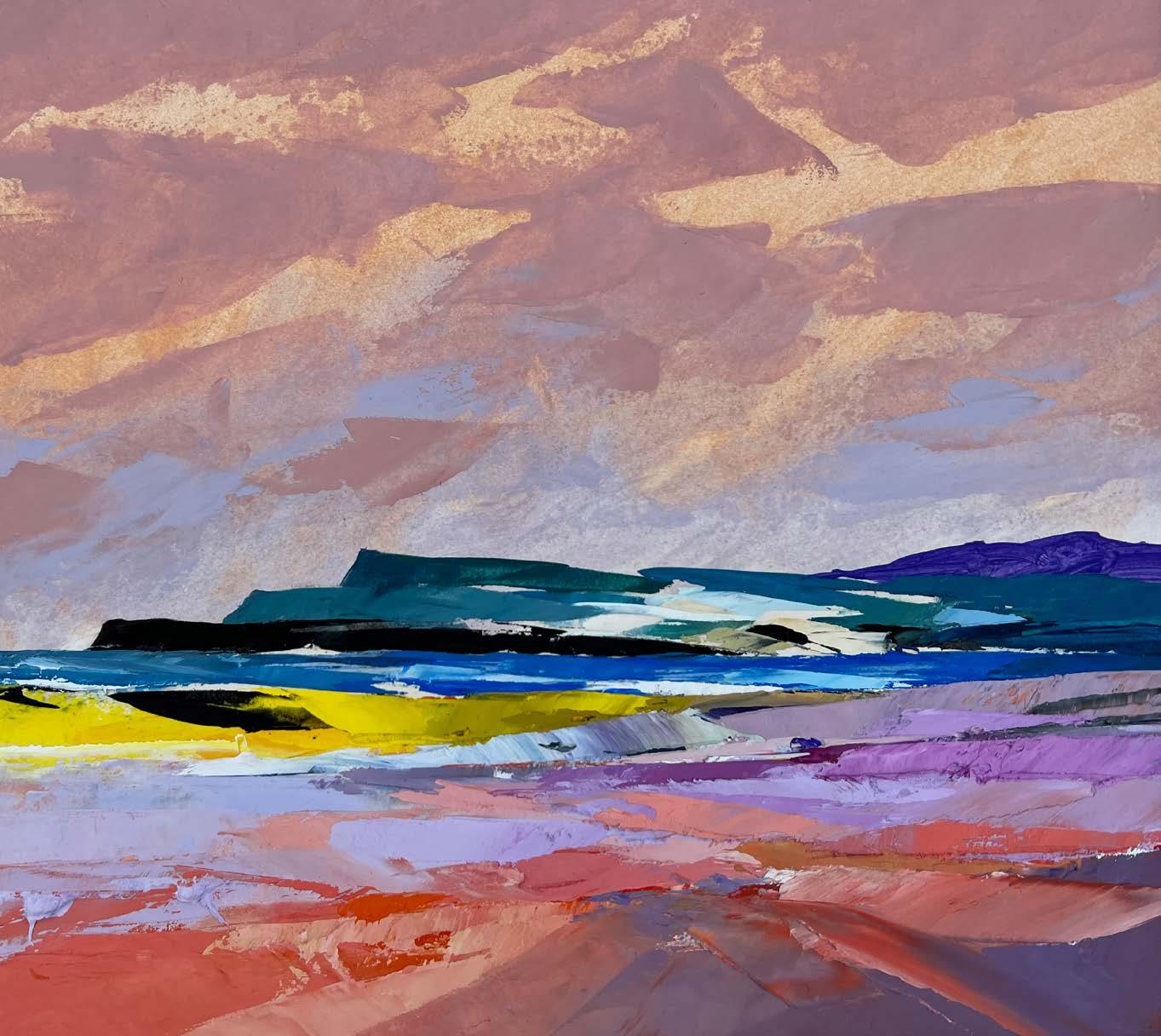
Boats on the Foreshore, Portskerra

Oil on Paper
39 x 58 cms / 15½" x 22¾"
Provenance
Private Collection, UK.
Gladwell & Patterson, London; acquired from the above in 2021.
8
Donald Hamilton Fraser
British, (1929-2009)
Donald Hamilton Fraser is a highly acclaimed British painter. Fraser dramatised his subjects with bold colours and a confident brush. His work employs a language of visual metaphor in which abstract and descriptive elements combine to express a heightened experience of the subject.
Inspired by the Scottish Highlands of his ancestors, Fraser depicted the rugged landscape like no other artist. Captured in all its myriad guises, according to the fleeting effects of light and atmosphere, he transformed the Highland landscape into vivid swathes of colour.
Fraser was a master at capturing an array of subjects, from the natural landscape to vibrant still lives. He adored the expressive nature of paint and the striking juxtaposition of primary colours, often layering them onto the canvas with a palette knife to produce an almost collage-like effect. Under his deft brush, the tradition of landscape painting is distorted to form abstract almost dream-like fields of colour.
Fraser was born in London to Scottish parents. His father was an antiques dealer, and Fraser’s childhood was spent surrounded by beautiful objects and art. Fraser developed a keen interest in literature, reading voraciously and writing poetry, and he began to train as a journalist with Kemsley Newspapers before completing a period of national service in the Royal Air Force in the late 1940s.
Fraser studied at the prestigious St. Martin's School of Art from 1949 to 1952 alongside notable contemporaries including Jack Smith, Leon Kossoff, Frank Auerbach and his close friend Peter Kinley. For many young artists in the early 1950s, they felt a need to become either an abstract or a figurative artist. Fraser did not feel these had to be mutually exclusive, and an exhibition of the work of Nicolas de Staël at Matthiesson's on Bond Street in 1952 acted as catalyst to reconcile these two styles within his work.
Over the course of his career, Fraser had frequent one man exhibitions at Gimpel Fils in London and Paul Rosenberg Gallery in New York. From 1958 to 1983 Fraser taught at the Royal College of Art. During this fellowship, he taught many notable young artists that would go on to be leading figures of their generation, including David Hockney, Ronald Brooks Kitaj, Patrick Caulfield and Thesese Oulton. Fraser became a Fellow of the Royal College of Art in 1970 and was elected as a member of the Royal Academy in 1975. In Fraser’s later years, he received many private and public commissions and took part in frequent gallery exhibitions throughout Britain. Shortly before he passed away, two major retrospectives of his work were held in London at Arthur Ackerman and the CCA Galleries.
9

Peter Wileman
British, (Contemporary)
“For me, painting is as much a part of the day as eating and sleeping. In fact, it’s more important than that, more like breathing! I could not imagine a single day passing without talking about, reading about, or actually taking part in some kind of activity concerning art. Like a moth is drawn to a flame, a painter is drawn to the light, and although I have tried to express myself with painting in many different forms, mediums and styles over the years, my path has lead me inexorably, like so many others before me, to try and capture that elusive quality of light, that only a shimmering sunset, dawn of a new day, dazzling sparkle of reflection off both sea and river presents to one who is prepared to both look and see.”
- - Peter Wileman

11
Twilight Intensity Oil on Canvas 90 x 120 cms / 35½” x 47¼”
Peter Wileman
British, (Contemporary)
Across the Bar
Oil on Canvas
40 x 40 cms / 15¾" x 15¾"
Highly acclaimed British abstract artist Peter Wileman is one of the UK’s leading contemporary landscape artists today. Known for his dazzling abstracted oil landscapes, Wileman’s style is bold and vigorous, both in the use of colour and handling of paint, as he explores the effect of light on his subject. Seeking atmosphere through light and colour, he works in varying degrees of abstraction.
Interested in painting from a young age, upon leaving school he went straight into his first job at Hallmark Cards, a card company, where his innate artistic talent was immediately recognised. Here Peter spent five years studying lettering and design, his first artistic training - which gave him a solid grounding in colour awareness and formal structure. Wileman later became the art editor on a number of magazines. Looking for an opportunity to develop his own artwork, Peter left his budding design career to become a freelance artist; a decision from which he has never looked back.

12
Peter Wileman

British, (Contemporary)
A Dream within a Dream
Oil on Canvas
80 x 80 cms / 31½” x 31½”
Music for Those that Listen
Oil on Canvas
40 x 40 cms / 15¾" x 15¾"
Wileman’s style is bold and vigorous, both in the use of colour and handling of paint, as he explores the effect of light on his subject. Working exclusively in oils, the medium most adaptable to changes of light and mood, he evokes atmosphere through light and colour through varying degrees of abstraction. Wileman’s work is reminiscent of the great master Joseph Mallord William Turner through its atmospheric quality. His work has a superb energy, with paint applied in washes and also with areas of impasto. The foregrounds are complex, but not disctracting to the subject within his work.
Over the last two decades Wileman has exhibited regularly at a number of prestigious art venues including the Royal Society of Marine Artists, the New England Art Club and the Royal Institute of Oil Painters of which he is an associate member. Wileman has built a distinguished reputation as one of the finest landscape artists practising in the UK today.
13

14 A Dream within a Dream Oil on Canvas
x 80 cms / 31½” x 31½”
80

15
Secret Haven
Oil on Canvas
80 x 80 cms / 31½” x 31½”

16 A Sense of Wonder Oil on Canvas 80 x 80 cms / 31½” x 31½”
 Inner Peace
Oil on Canvas
Inner Peace
Oil on Canvas
17
80 x 80 cms / 31½” x 31½”

18
Ivon Hitchens CBE
British, (1893-1979)
April Haze, No. 3
Painted in 1957
Oil on Canvas
43 x 109 cms / 17” x 43”
Price on Application
Provenance
The artist’s studio.
Kenneth Webb, UK; acquired from the artist in the 1970s.
19
Ivon Hitchens CBE British, (1893-1979)
Beyond his great importance to twentieth century British painting, Ivon Hitchens holds added significance for Gladwell & Patterson for the influence he would have on one our leading painters, Kenneth Webb. Webb has admired the work of Ivon Hitchens since the early years of his studies and his influence can be seen throughout the younger artist’s work, particularly his Field Poppies and Myths and Legends series. The two first met at Hitchens’ 80th birthday in 1973, where they formed an immediate friendship. Both artists would often meet and share their technical experience and insights. Thus, while Hitchens was a significant visual source of Webb’s aesthetics, it would be the younger artist who introduced Hitchens to the experimental effects which could be achieved through the use of acrylic paints.
Sitting in a liminal space between the binary of abstract and figurative painting, both artists applied elements of these two stylistic poles in their respective quests to capture their immediate surroundings and create a new form of expressive landscape. As the critic Patrick Heron put it in the mid-1950s ‘Hitchens in West Sussex provides the most distinguished example of profound personal identification of a painter with a special place or landscape’. While Hitchens may have moved close to abstraction, his immersion in his beloved West Sussex environment would always ground his work in a very real topography. The close perspectives and solid planes of colour found in his landscapes evoke the sense of an artist submerged in the woods and ponds around his Petworth home. It is this attachment to their surroundings that most clearly unites Kenneth and Ivon.
It is therefore of particular significance that both the present works, April Haze no. 3 and Wildflower Wood , have been a part of Kenneth Webb’s personal collection. As such they not only symbolise the shared artistic development of the two artists, but offer a physical reminder of how the journey of artworks between collections can serve to add greater meaning to the paintings themselves. That Kenneth Webb, one of Hitchens’ greatest admirers, choose these two examples of the older artist’s works is the clearest testimony as to their importance as paradigms of his style.
20


22
Ivon Hitchens CBE
British, (1893-1979)
Wildflower Wood
Painted in 1975
Oil on Canvas
40.5 x 74 cms / 16” x 29”
Price on Application
Provenance
The artist’s studio.
Waddington Galleries Ltd., London.
Kenneth Webb, UK; acquired from the above in the 1970s.
23
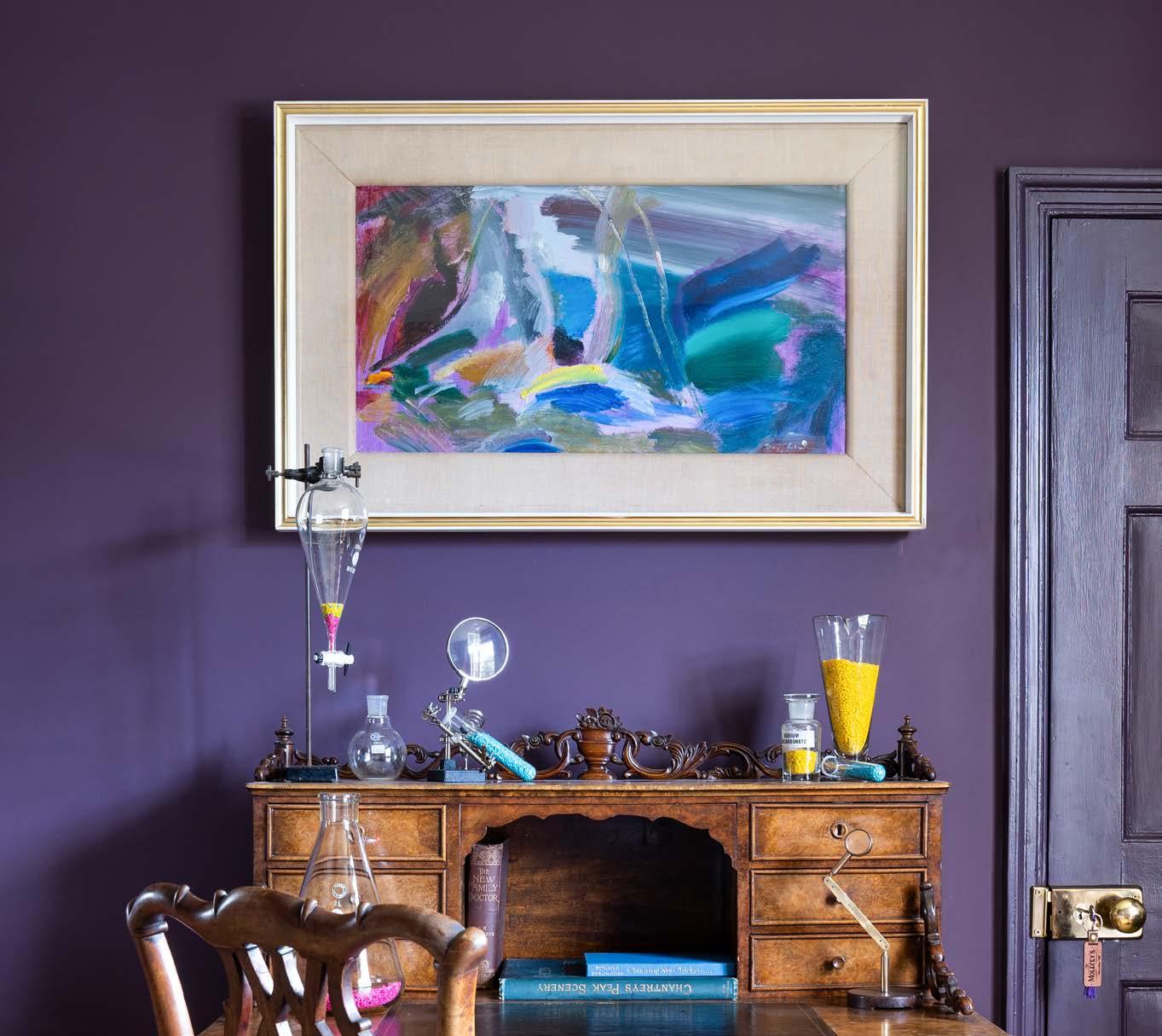
Ivon Hitchens CBE
British, (1893-1979)
Wildflower Wood was acquired soon after it left Hitchens’ studio in the mid 1970s. With its bold greens, pinks and blues, the work bears testament to its painter’s continual development well into his eighties and may well allude to the reciprocal influence that Kenneth Webb’s bright colouring had on the older artist. In contrast, April Haze no. 3 was created during Hitchens’ most celebrated phase as an artist, between representing Britain at the 1956 Venice Biennale alongside Lynn Chadwick and receiving his CBE in 1958.
The doorway to Hitchen’s studio is depicted to the left, surrounded by trees, which emerge out of a panoramic sweep which at first glance appears abstract, an effect emblematic of Hitchens’ entire style. Ivon Hitchens would keep this painting in his studio for well over a decade, until Webb acquired it in the early 1970s. These two works, which have been in Webb’s collection for nearly fifty years, are thus brilliant examples of both artist’s shared goals in colouring and abstraction.
A final consequence of the journey from one artist’s studio to another is the often-forgotten element of a painting’s framing. Hitchens was famously specific about how his works should be framed, specifying that they should remain in the wide-bordered, pale wooden settings that he himself designed. Unfortunately, after his passing, many galleries and owners sought to change these frames to fit ever-changing contemporary tastes, decisions which have resulted in the loss of a great number of these integral parts of the artwork. Yet, precisely because April Haze and Wildflower Wood passed directly from the artist to a close friend, both of their frames have remained in excellent condition. To this day, their survival helps to contextualise and inform the artworks they hold, just as Hitchens intended them to.
These paintings are therefore wonderful examples of the importance that the provenance and journey can have on how we see artworks. Taken independently of their history, these paintings are rich evocations of the power of Hitchens’ craft from his mature to his late phase. Yet it is the addition of their journeys that serves to magnify and enrich their importance and meaning. Not only do both paintings testify to the symbiotic relationship shared by Hitchens and his most important follower, Kenneth Webb, but their direct passing between these artists serves to illustrate important themes of preservation and the common goals of both figures.
25
The Forenoon
16.5 x 11.5 cms / 6½" x 4½"
16.5 x 11.5 cms / 6½" x 4½"


26
Oil on Board
Twilight Musk
Oil on Board
Kenneth Webb
Irish, (Contemporary)

27
Kenneth Webb
Irish, (Contemporary)
Kenneth Webb is considered to be one of the finest landscape painters of the last one-hundred years. Over the course of his career, Kenneth’s landscape painting has evolved through several significant phases over his many decades of painting - in terms of both subject and technique, and today he continues to create and innovate through his art.
Kenneth has spent his life creating spectacular paintings so that we might share his own individual reaction and impression to the natural world around us. Kenneth’s paintings are an exploration and celebration of the natural world through colour. Experimenting with colour in a free, expressionist manner since his art school years, Kenneth has arrived at a joyous aesthetic that captivates and envelops the viewer. Taking inspiration from the natural landscape around him, from his garden and his studio in Connemara on the west coast of Ireland, his paintings are rooted in place and are deeply personal.
From vibrant, attention grabbing poppies to ethereal waterlilies, Kenneth has always sought out the beauty in the natural world that surrounds him. From the south coast of Devon to the rugged landscape of Connemara, Kenneth’s artistic milieu has enabled him to constantly evolve and reimagine his subjects.
Despite their range, none of these themes has been entirely isolated or completed; Kenneth continually revisits subjects and techniques, adapting his approach and combining ideas in his eternal quest to truly capture the mood, the emotion - the spiritual essence - of a landscape.
Over the course of Kenneth’s lengthy artistic career, he has shown works at numerous notable institutions, including the Royal Academy in London. Kenneth founded the Irish School of Landscape painting in 1957 and has since lectured at the Tate Gallery, Victoria and Albert Museum and the National Gallery in London.
Kenneth’s paintings are celebrated and collected internationally, with his work placed in prestigious collections across the world. Gladwell & Patterson have represented Kenneth Webb in London since 2010 and in that time his monumental works have found fame with important collectors in China, America and the United Kingdom.
28

29
Summer Poppies
Oil on Canvas
53.5 x 63.5 cms / 21" x 25"w
Georges Bauquier
French, (1910-1997)
Nature Morte aux Deux Pommes, No. 5
Oil on Canvas

92 x 73 cms / 36” x 29”
Provenance
Studio of Georges Bauquier, France.
Private Collection, France; acquired from the above. Gladwell & Patterson, London; acquired in March 2022.
Exhibitions
Cannes, La Malmaison, Georges Bauquier : Natures Mortes à la Fenêtre, December 2002 – February 2003, (reproduced on page 53 of the catalogue.
Vascoeuil, Château de Vascoeuil, Georges Bauquier 1910 – 1997 : Paintings – Gouaches – Drawings, March to June 2005.
30
Bauquier’s Nature Morte aux Deux Pommes, No. 5 was painted in the middle of the artist’s mature phase. One of a series of still lifes, all of which bear an identical title, the paintings in this series all reiterate similar motifs; two apples positioned on top of a gathered table cloth within a striking interior backdrop. Vibrant wall paper, as in the present work features heavily throughout this series adding to the depth and drama of each composition.
Larger in size than most of the painter’s output, Bauquier clearly saw these pieces as emblematic of his style. Strongly structured and vividly coloured, the artist balances his cubist roots with his personal love of expressive colouration. From the beginning of the 1960s, when Bauquier had begun to truly move out of Léger’s shadow, his work had begun to assume the characteristics we find in Nature Morte aux Deux Pommes, No. 5 ; an interior still life spread across large surfaces of colour.
Nature Morte aux Deux Pommes, No. 5 is most interesting for its return to a central motif for the painter: foliage. Many of the artist’s earliest works concern themselves with plants and trees reaching outwards and spreading their leaves, an analogy to his growing artistic independence, yet as the artist more confidently adopted his own style of still lives these vignettes began to disappear. Nature Morte aux Deux Pommes, No. 5 therefore represents a far more biographical composition than is commonly seen in his work: synthesising his personal late style with a memory of his early years working with Léger.

31
31
Georges Bauquier in his studio
Georges Bauquier French, (1910-1997)
Georges Bauquier’s career is defined by his intimate personal and professional relationship with the great Cubist master, Fernand Léger. For twenty years the two painters worked closely together, and after Léger’s death Bauquier would be instrumental in both founding a museum dedicated to the artist and writing his eight volume Catalogue Raisonné.
Crucially, despite effectively remaining in Léger’s shadow until the older painter’s death in 1955, Bauquier was able to create his own synthesis of Cubism, creating a personal style that combined Léger, Braque and Cézanne for which he is increasingly lauded.
As the French critic Tabaraud notes:
“It cannot appear easy to be, for the twenty years from 1936 to his death, both the friend and closest daily collaborator of Fernand Léger and still pursue autonomous pictorial research, yet through constant study in the secrecy of the studio Bauquier was still able to find a personal identity.”
Born in 1910 in Nîmes, Bauquier would decide to become an artist in his early twenties, enrolling the School of Fine Arts in Paris in 1934, where received a first-rate classical education in draughtsmanship. However, after becoming increasingly dissatisfied at the constraints of academic painting, Bauquier would join the School of Contemporary Art in 1936, where he immediately began to work closely under, Fernand Léger, who the School’s director.
During the Second World War where the young artist joined the Communist Party and French Resistance, which culminating in a period of imprisonment by Nazi occupiers. Upon release, he reunited with Léger. During the following decade the two artists would work together daily; so close was Bauquier’s relationship with Léger, that after the latter’s death in 1955 he married Léger’s widow, Nadia. Alongside his wife, Bauquier immediately set about creating a museum to celebrate Léger’s life, which they opened in 1960 and would subsequently furnish with 348 works by Léger.
Bauquier’s personal style would develop quickly, and while he often declined to publicise his output, his exhibitions in the early 1950s were prefaced by Léger and saw great success in Paris. His works are usually predicated on a balance between great colouristic freedom and maintaining rigid compositional principles which he had learned from his teacher. Bauquier’s best known pieces are his still lifes, which occupy bold, often Cubist-inspired interiors, and frequently feature the artist’s favoured motif, a single piece of vegetation.
32
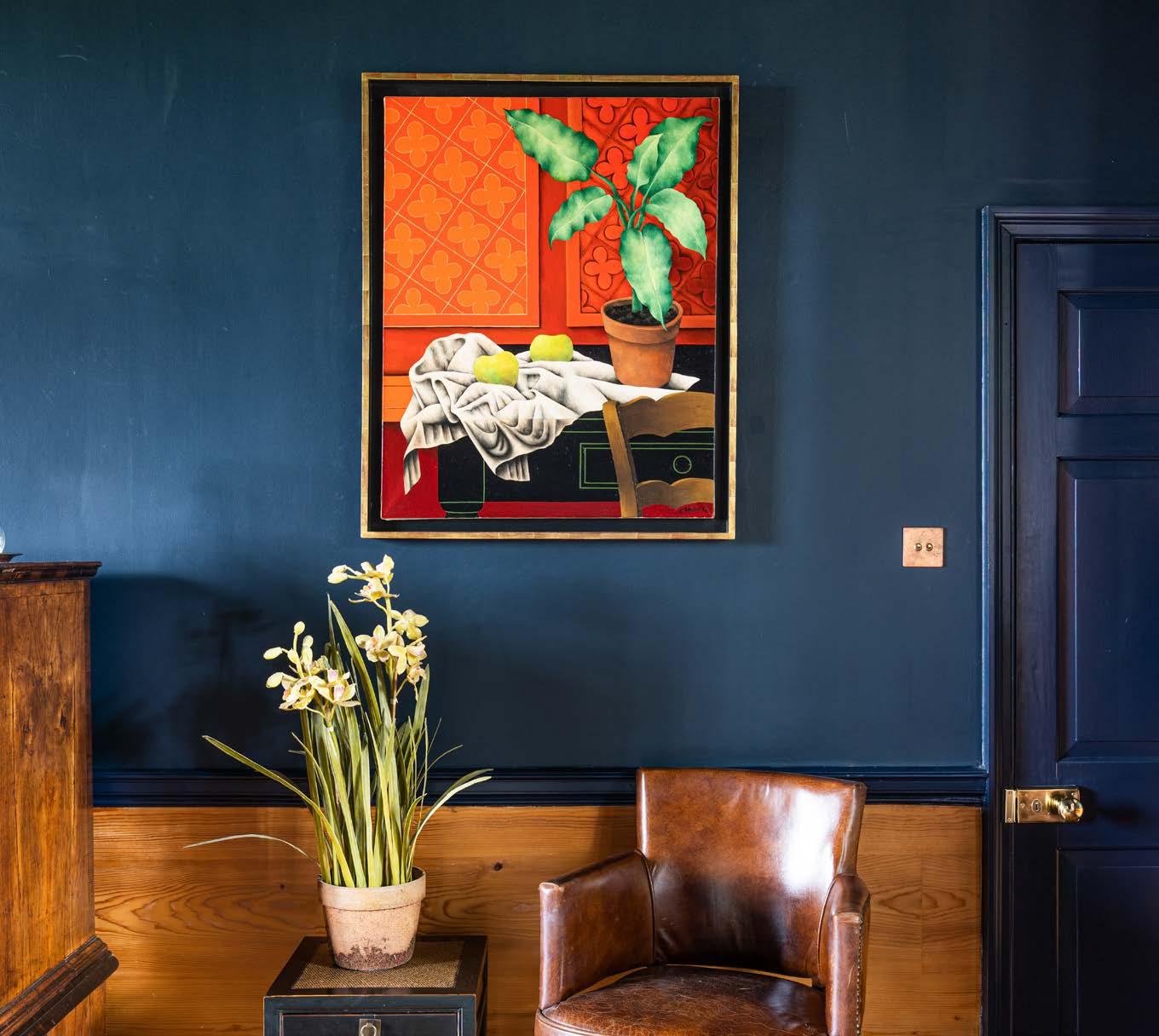
Georges Terzian
French, (Contemporary)
The title of the canvas, Cache Cache , translates as hide-and-seek: an apt description for the cubist style which features so heavily in the work. Terzian presents the viewer with a complex combination of geometry and texture, in which they are invited to find hidden forms and shapes. Terzian is particularly known for his experiments with the formation of different objects, often breaking down his subjects into purely abstract components, and Cache Cache stands as one of the artist’s most abstract pieces. With its sharp pointed lines, diverse colours and complex textures, this canvas by Terzian is therefore a perfect encapsulation of the lineage of cubist and constructivist techniques he so successfully emulated.
Cache Cache is typical of Terzian’s work in the 1980s. Where his earlier paintings were often figurative or based on landscapes, and his later works evoke a sculptural prototype, delineating a single abstract solid, this middle period is perhaps the closest the artist came to a pure cubist style. At the same time, Terzian’s main inspiration moved away from Cézanne and towards Picasso, Braque and Leger, his paintings becoming increasingly colourful. This period would also see the artist incorporating Russian constructivist practices into his compositions, bringing a linear straightness to previously sinuous lines.
Cache Cache
Oil on Canvas
50 x 73 cms / 19¾” x 28¾”
Provenance
Private Collection, France.
Gladwell & Patterson, London ; acquired in July 2022.
34

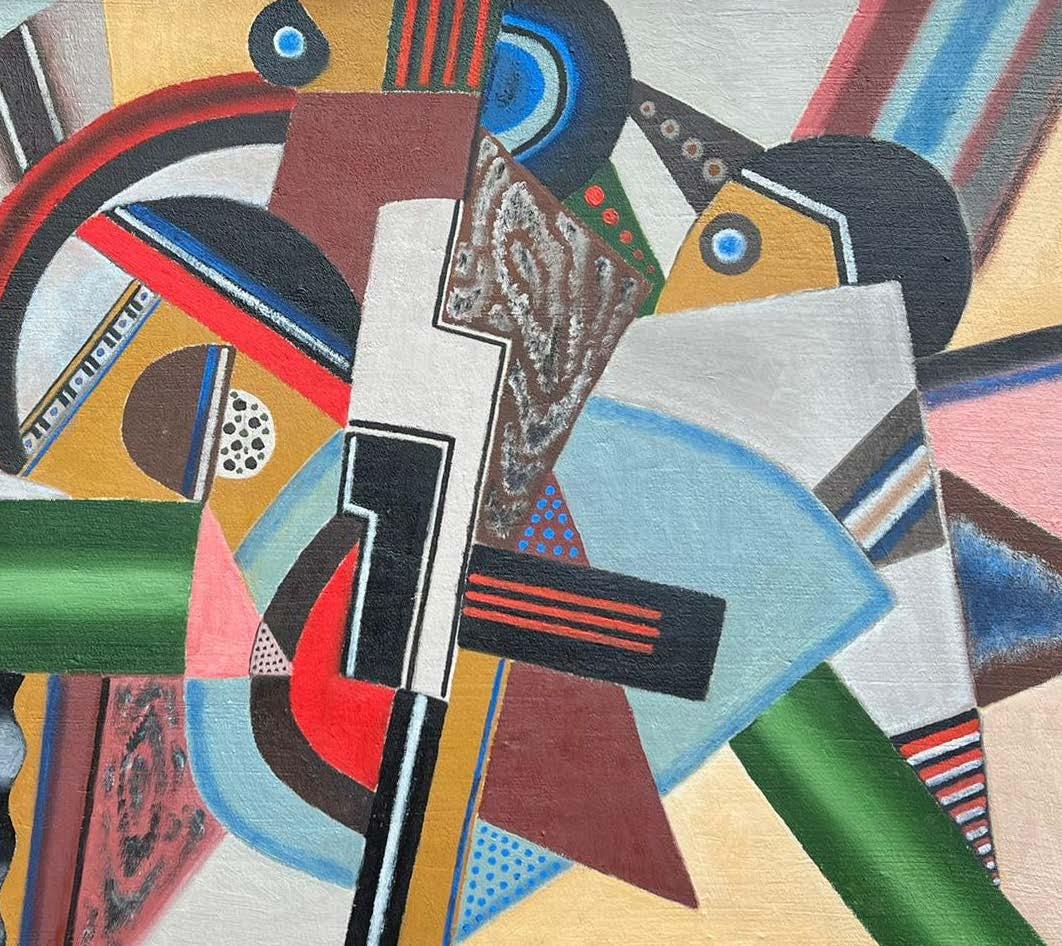
Georges Terzian
French, (Contemporary)
George Terzian is a French Postwar & Contemporary painter known for his vibrant, abstract and geometric compositions. Terzian moved to Paris in the 1960s and became a cabaret singer which enabled him to pursue his passion for painting. There he would turn to the cubist style for which he is celebrated, forming a synthesis of Picasso, Braque and Leger’s early work in his unique, post cubist style.
Terzian's work is heavily influenced by the geometric abstraction movement, which emerged in the early twentieth century and emphasizes the use of geometric shapes and forms to create abstract compositions. His paintings are characterized by their precise and clean lines, bold colors, and geometric shapes. He often uses a limited palette of colors, such as black and white, to create a sense of harmony and balance in his compositions.
Terzian was born in Marseille in 1939, to parents of Armenian descent. His family had left their homeland for Russia at the start of the twentieth century, although they would then settle in France shortly before the artist’s birth. Georges took an early interest in drawing and painting, and his parents therefore encouraged him to join the Ecole des Beaux-Arts in Marseilles at the age of fourteen. From a studio in Sainte-Miter, he would experiment with impressionist techniques en plein air in the Provençal countryside, working in gouache and oils in a manner reminiscent of Cèzanne, continually honing his technique.
Yet Terzian was clearly a man with an eclectic taste which ran beyond his skill as an artist. In the midst of his studies in art school, Terzian discovered a love of boot making, which prompted him to interrupt his education for over a year while he studied the craft. When he moved to Paris at the age of twenty, he also elected to study music, and took lessons from the famous singer Jean Lumière. In fact, while his style began to transition towards cubism in the early 1960s, it was his job as a cabaret singer which would support the young artist financially. It is easy to see Terzian’s polymathic nature in his mature paintings, which draw from a wide range of styles and cultures to create their inimitable modernist feel. His musical studies in particular bring a symphonic, lyrical quality to his works reminiscent of artists such as Kandinsky.
The influence of the work of Picasso, Braque and Leger remains constant throughout his oeuvre, while maintaining a personal style. His iconography also draws on the North African cultures Terzian interacted with during his many stays in Africa, alongside Russian constructivist motifs from his time living in Moscow.
Throughout his career, Terzian has had numerous solo and group exhibitions in France and internationally, and he continues to paint from his studio in Paris. Following a one-man exhibition of his work at the Parisian Giovanni gallery in 2007 his works have become increasingly wellknown on the international stage. The public interest in his works has also led to his much rarer early works gaining a particular popularity.
37
Pablo Picasso Spanish (1881–1973)
"It is Jacqueline’s images that dominates Picasso’s work from 1954 until his death, longer than any of the women who preceded her. It is her body that we are able to explore more exhaustively and more intimately than any other body in the history of art."
Jacqueline au Bandeau
Conceived in 1962, Cast in bronze in 1964
Bronze relief sculpture cast from a linocut
34.6 x 26.6 cms, /13½” x 10½”
Stamped with the foundry mark ‘E. GodArd Fondr Paris’
Unnumbered edition of 2
Provenance
Estate of the Artist
Marina Picasso, the artist’s granddaughter; acquired from the above. Gladwell & Patterson, London; acquired from the above in 2022.
Claude Picasso has confirmed the authenticity of this work.
38

39

40
Pablo Picasso’s Jacqueline au Bandeau encapsulates the startling vitality of the artist’s late period, memorialising not only the expressive style which he pioneered; but also his reinvention of the possibilities of printmaking. Picasso commissioned this bronze relief in 1964, of an original linocut entitled Femme au Cheveux Flous, which he created two years prior, as a unique encapsulation of one of his most accomplished print series. Cherished first by Picasso and then his descendants for nearly sixty years, we are proud to present this distinctive work to the public for the first time.
Following his marriage to Jacqueline Roque in 1961, Picasso would embark upon a period of intense experimentation and production, which would characterise his final decade. In these years, the great artist focused his gaze upon subjects he considered to be pure archetypes; foremost amongst these were the face of his muse, Jacqueline.


Picasso always experienced bursts of creative energy when in love, and Jacqueline au Bandeau was conceived in 1962 only shortly after his marriage, one of a group of portraits testifying to his intensity of feeling. More than simple representations, Picasso composed his portraits of Jacqueline from memory, creating some of his most personal and subjective interpretations of the human character.
Yet beyond its striking visuals, Jacqueline au Bandeau stands as a near-unique material record of Picasso’s revolutionary impact on the print medium. In the early 1960s, Picasso would pioneer the reductive method of producing linocuts, greatly expanding the technical possibilities it afforded artists.
Aware of his achievement, Picasso chose to memorialise a small selection his best linocuts in bronze, transforming them into accomplished relief sculptures in their own right. Each line and groove of Jacqueline au Bandeau therefore represents a rare physical imprint of Picasso’s hand as he worked and reworked the printing block. A testament to both stylistic and technical innovation, Picasso’s bronze relief offers the viewer an outstanding opportunity to experience a direct material connection to his genius.
41

Pablo Picasso
Spanish (1881–1973)
La Serrure
Knitted Wool Tapestry
Designed and Created in 1955
205 x 150 cms ; 81” x 59”
Signed ‘Picasso’
Provenance
Commissioned by Marie Cuttoli.
Lucie Weill Gallery.
Private Collection; France.
Gladwell & Patterson, London; acquired in 2022.
Claude Picasso has confirmed the authenticity of this work.
43
Out of all of Picasso’s unrivalled contributions to twentieth century culture, his successes in elevating decorative media to the status of a fine art is perhaps his most significant legacy. From collage, to ceramics, to printmaking, he continually sought to expand the material language of art; yet the field upon which he had the greatest impact were tapestries and textiles. La Serrure , a knitted wool tapestry designed by the artist and made in 1955, thus stands as an encapsulation of his achievement.
La Serrure was commissioned in 1955 by Marie Cuttoli, a French designer instrumental in the resurgence of twentieth-century tapestry. Cuttoli had, from the 1930s, enlisted a range of artists (including Miró, Man Ray, Leger, Braque and Picasso) to support her project of rescuing the status of textile art. The importance and extent of her contribution is the subject of numerous exhibitions and studies to this day.
The design process involved Picasso creating a cartoon, a to-scale design on cardboard, which was then sent to weavers for manufacture. Throughout the creation of the final tapestry, Picasso periodically checked the unfinished work to ensure its quality was at the highest standard and it was being made according to his plans.
La Serrure is unique amongst Picasso’s woven creations for its use of an original composition. Picasso’s tapestries were often produced as reinterpretations and reproductions of his canvases, most famously in the case of Picasso’s monumental Guernica of 1937, which hung outside the chambers of the Security Council of the UN. There is no painted precedent for La Serrure The textile thus stands as an artwork in its own right.
Translated as ‘The Lock’, La Serrure is a fine example of Picasso’s confidence in translating his style across media. Intended to be used as a carpet, the image of a figure appearing through a keyhole alludes to the domestic setting implied by the artwork in a way rarely attempted by Picasso. The motif of the dove in the upper left corner, outlined in both black and green plays homage to the recurring motif of La Colombe that Picasso incorporates into his work throughout his oeuvre. Standing as a symbol of peace, its presence in the domestic setting is a deeply personal motif for Picasso, who adored animals, and allowed them to run freely around his house and studio. The vibrant colours of red and green with the lineal outlines of the subject in black are juxtaposed against the cream background, revealing Picasso’s confident approach to interior furnishings.
44
Pablo Picasso studying a tapestry in Cannes, 1959
Photograph by Edward Quinn Musee National Picasso-Paris
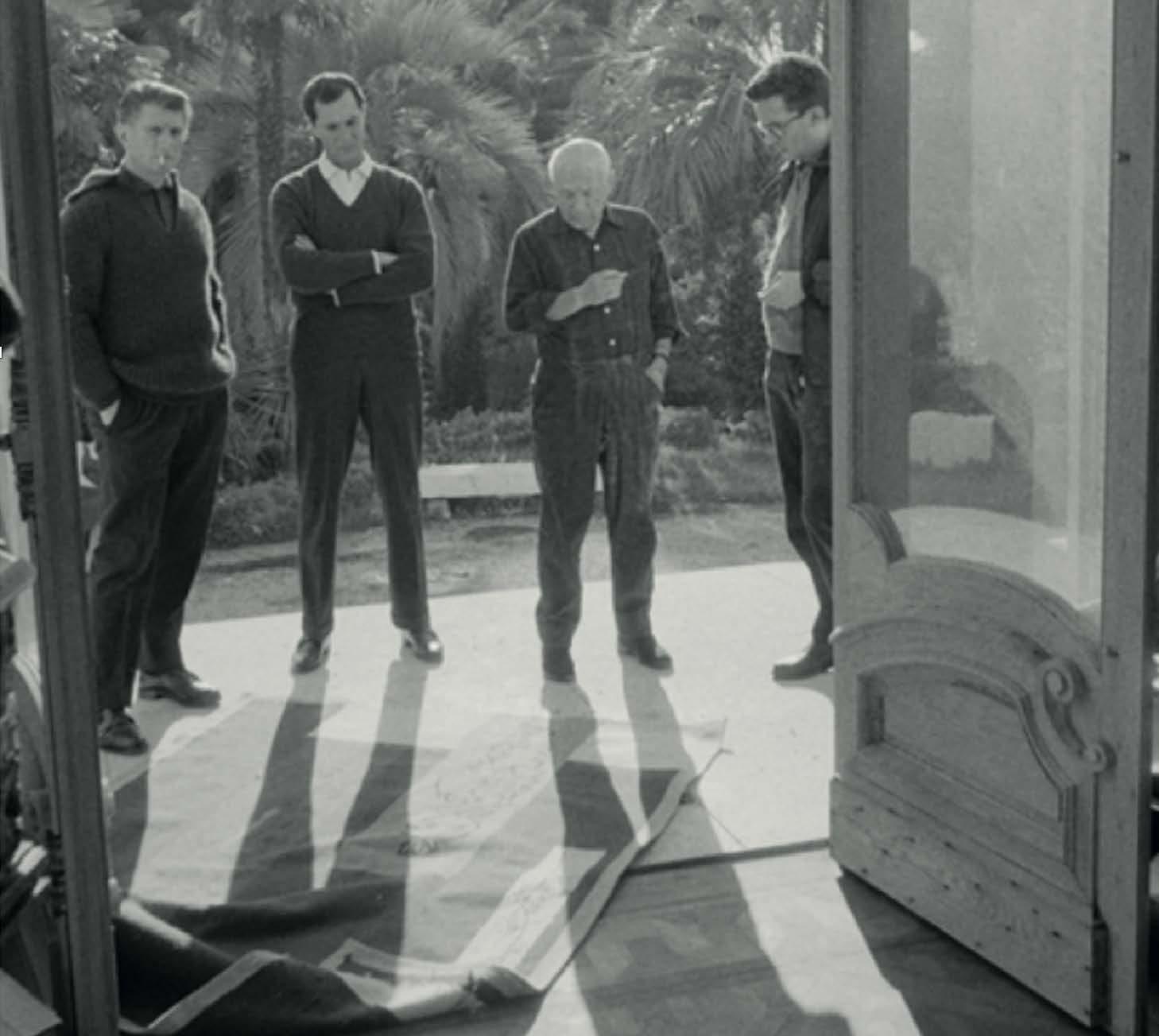
Gladwell & Patterson, London
A stones throw away from Harrods, in London's prestigious Knightsbridge, our gallery offers the very finest artworks in a luxurious and comfortable setting. Visit us for a coffee or glass of champagne on your next visit to London.
5 Beauchamp Place, Knightsbridge, London, SW3 1NG

46
44 (0)
Email: emily@gladwellpatterson.com Open:
Tel: +
207 584 5512
Monday - Friday 10am - 6pm / Saturday 11am - 4pm
Gladwells Rutland, Oakham
Situated in a beautiful historic market town in the very heart of Rutland, England’s smallest county, our country outpost has become a must visit destination for many. Away from the hustle and bustle of London, it is definitely worth taking the time to come and visit us here. 23b

47
Street
Rutland, LE15 6EA Tel: + 44 (0) 1572 756518 Email: rutland@gladwellpatterson.com Open: Monday - Friday 10am - 4pm, / Saturday 11am - 3pm
Mill
Oakham,
Index
Georges Bauquier p.30-33
Donald Hamilton Fraser p. 6-9
Ivon Hitchens p.18-25
David Leverett p. 2-5
Pablo Picasso p. 38-45
Goeorges Terzian p. 34-37
Kenneth Webb p. 26-29
Peter Wileman p. 10-17
For further information on any of these artworks please contact the gallery
Glenn Fuller (Director) glenn@gladwellpatterson.com +44 (0)776 782 4245
Research: Will Stewart and Ella Wells, Design: Ella Wells
All Rights Reserved Gladwell & Patterson, 2023
48
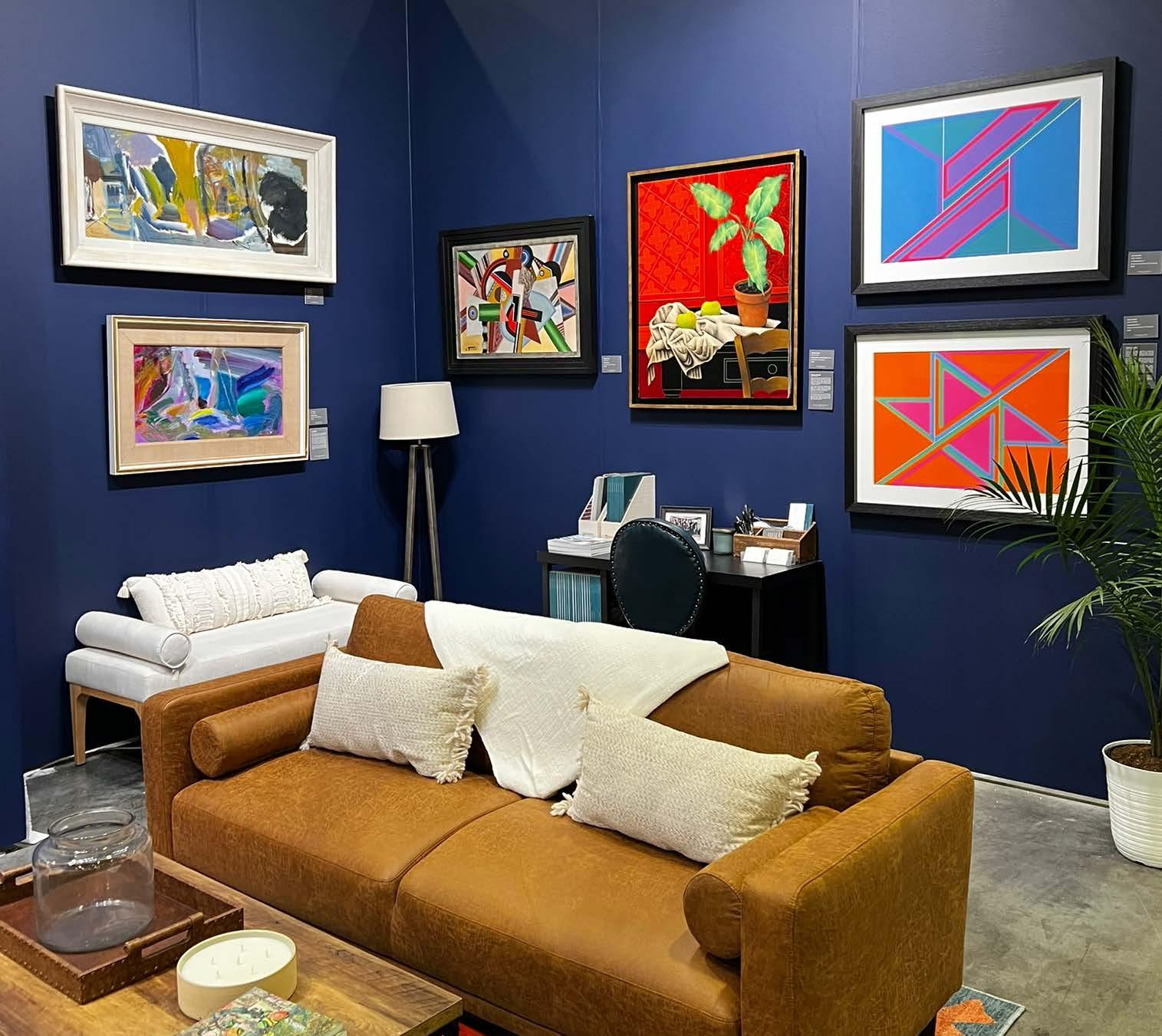
5 Beauchamp Place, London SW3 1NG • +44 (0)20 7584 5512 • glenn@gladwellpatterson.com • gladwellpatterson.com

























 Inner Peace
Oil on Canvas
Inner Peace
Oil on Canvas






















